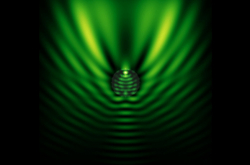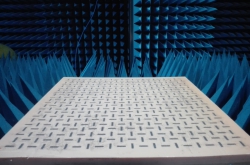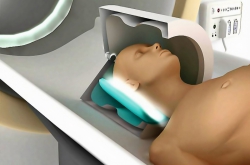The standard method
Magnetic resonance imaging is based on the excitation of magnetic resonance in the body and the registration of the radio frequency response. The excitation in question is created by a uniformly distributed radio-frequency magnetic field. At the same time, there is a strong permanent magnetic field (1.5-3 T for medical MRI) inside the imaging unit. The combination of permanent and radio frequency fields affects the hydrogen atoms in the soft tissues of the body. These conditions create nuclear magnetic resonance which leads to a strong synchronous change in the spin direction of protons. Once the excitation ceases, atoms gradually return to their original state. However, all protons emit radio-frequency radiation during this transition. In different organs and tissues, this radiation will vary because of the different proton concentration, which makes it possible to obtain a contrast image, which is registered by a special antenna. The received signal is then transmitted to the receivers, digitized and analyzed by the computer. MRI antennas are historically called radiofrequency coils.
In clinical imaging units, such excitation is carried out by a single transmitting coil, invisible to the patient and located under the inner casing of the imaging unit. It would be convenient to use it to receive radio frequency response of protons but is rarely done because of the coil’s very low sensitivity. The protons’ response is so weak that it can be isolated from the background noise only if the receiving antenna is located on the patient. Therefore, in every MRI center, there is a set of receiving antennas specially designed for scanning various organs and parts of the body. There are receiving coils for the head, body, limbs, back, etc. Before a scan, the receiving coil is placed on the patient and connected to the receiver via a cable. Receiving coils are expensive because of their uniqueness, and are manufactured along with the imaging unit by the same company. Otherwise, it is impossible to connect the coil to the imaging unit because of identification systems.

Current progress
ITMO University's scientists have developed a way to use the coil without a cable connection. In order to do this, one needs to make sure that the signal from the receiving coil (the one that is put on the studied area of the body) can reach the receiver not by cable, but wirelessly.
How can this be done? The receiving coil must be improved and connected to the inbuilt coil by means of a resonant inductive coupling. In the method proposed, a wireless receiving coil - a specially designed resonator located on the patient, receives the radio frequency response. Then the signal is wirelessly transmitted (almost without loss) to the inbuilt coil with no cables. Only then does it get to the receiver.
Scientists of the Nanophotonics and Metamaterials International Center at ITMO University have developed a new wireless coil structure, which is similar to the structure of elementary cells of metamaterials. It is a metasolenoid - a periodic structure of open circuits that operates as a solenoid with a uniform magnetic field only in the radio frequency range and does not interact with the permanent field of the magnet. This metasolenoid and the birdcage coil, which is embedded in the bore of a scannerб form a system of inductively-coupled resonators at the operating frequency of the imaging unit (63.8 MHz for a clinical imaging unit with a 1.5 T magnet field), achieving wireless signal transmission.
In this case, the wireless coil also helps to focus the inbuilt coil's field. By using the metasolenoid as a wireless coil, a uniform magnetic field can be formed throughout the entire focusing region. Therefore, the magnetic field is concentrated only within the scanning area, on a certain part of the body.

Using a wireless coil enables the scientists to excite protons at the same level of the radio frequency magnetic field while using a transmitter that is 50 times less powerful. The signal is wirelessly delivered to the receiver with virtually no loss.
“The tests of the wireless coil have shown that it is no less efficient than the traditional wired coil, and can have an even lower signal loss factor than cable transmission. Thus, we get a better image with a better signal-to-noise ratio. In addition, the coil itself is convenient to use, as there is no need to connect it,” says one of the authors of the article, a researcher at the Department of Nano-Photonics and Metamaterials, Stanislav Glybovski.
His words are backed up by data since the clinical trials have already been conducted and comparisons with current commercial coils have been made.
Development and clinical trials
At the development stage of the wireless coil, ITMO University’s scientists collaborated with the specialists of S.P. Helpic LLC, a Russian medical diagnostic equipment manufacturer. The company provided its devices to study and debug the interaction mechanism between the wireless coil and the inbuilt coil.
Clinical trials of the developed coil were conducted within the framework of ITMO’s Institute of Translational Medicine in collaboration with the Magnetic Resonance Imaging department of the Almazov National Medical Research Center. The University Medical Center Utrecht in the Netherlands also provided consultations. However, before testing the coil on volunteers, the scientists had to pass an ethics committee evaluation.

This meant performing a computer simulation of a working wireless coil to demonstrate that it is harmless to the human body. A calculation and a detailed model of the human body helped to analyze magnetic fields’ distribution and the live tissue heating process. After that, the coil was tested on phantoms for about 18 months. Phantoms are containers filled with liquid that has the average electromagnetic properties of human body tissue. The researchers also used this time to properly adjust the imaging unit to the new coil. The Almazov Center’s experts supported the ITMO University team in this task.
After that, the actual clinical trials with healthy volunteers were started. Scientists scanned the volunteers’ wrist joints with the new wireless coil and a commercial cable-connected coil of the same size and then compared the quality of the images.
“We got the in vivo results. Our task was to convince the medical community that wireless signal transmission is quite effective in comparison to the standard method. Nobody has ever succeeded in this before and very few people have researched wireless coils. In an article published in the journal Magnetic Resonance in Medicine, we give the details on how our coil is made and how to apply it, so that both engineers and doctors could understand the technology behind it,” says Stanislav Glybovski.
A doctor’s opinion
Aleksander Efimtsev, head of the Radiology Research Lab at the Almazov Center, told us about the advantages of the new wireless coil from a physician’s point of view. He was also one of the authors of the article on the coil’s working principle.
Firstly, the absence of wires allows doctors to place the coil as close to the area under investigation as possible. This reduces the time it takes to prepare a patient and, therefore, the time it takes to perform a scan. Secondly, it would ensure the highest quality of scans for patients regardless of the size of their body parts that are being scanned. Thirdly, sometimes overweight patients do not fit into the radio-frequency coil and we have to use a flexible coil, thus lessening the image quality and increasing the time needed for a scan.

As for the wrist joint scans, they are mostly performed with a knee-joint coil, forcing patients to lie on their stomach with an outstretched arm for 20 minutes without moving. This is difficult, especially for the elderly: the hand gets numb, the patient stirs, the scan has to be restarted. A wireless coil allows patients to place their hands on their stomach and lie comfortably. As a result, the patient can take a nap while the doctors take all the time they might need for a scan, 20 or even 30 minutes. This is very important, stressed Aleksander Efimtsev
Standard coils have one downside - edge artifacts that arise due to a weak signal on the periphery. This does not happen to a wireless coil, and the image comes out absolutely homogeneous in brightness, contrast, and geometry. These small details may contain diagnostically vital information.
“The image quality of wireless coils is higher, even with standard pulse sequences, provided the correct settings are chosen for both the coil and the protocol. It is even more noticeable with special pulse sequences: T1-gradient echo, diffusion and diffusion-tensor imaging, MR spectroscopy. The quality is almost two times better! We are now developing a new coil for the head, the most unexplored part of the human body. We look forward to starting the tests. If everything goes well, it will bring brain disease studies to a new level. All in all, we can safely say that the coil we developed together with ITMO University’s team is worthwhile, outperforming the standard coils in many aspects,” comments Aleksander Efimtsev.
Future prospects

As of now, ITMO University scientists have only developed a wrist-joint coil. However, in the future, they plan to create coils for other organs and joints. Today there is a need to create coils for the mammary glands or other areas in which there are many small joints, cartilages, and tendons, such as feet or hands, explains the leading author of the article, Alena Shchelokova, a researcher at the Department of Nano-Photonics and Metamaterials. The better the solenoid coil receives the tissues’ radio-frequency response, the more detailed the final image will be.
“MRI is one of the few applications of metamaterials in the radio-frequency range. An antenna created in the likeness of metamaterials can register only a narrowband signal, and the imaging unit is actually working in a particular narrow band of frequencies. This example demonstrates how metamaterials can be applied in engineering. Interdisciplinary research plays an important role in this field. We initially thought that it would be enough for us to develop a coil and pass it on to the doctors so that they could decide how to apply it. However, in the course of our work, we saw that we could not create a device superior to the current wire coil without a detailed understanding of how the imaging unit works and what the doctors need from it. This knowledge will help to improve the MRI technology further,” stresses Alena Shchelokova.
Recognition by the scientific community
According to Stanislav and Alena, they were not sure that Magnetic Resonance in Medicine would accept their article. It is not easy to convince the scientific community that it was possible to make such a significant improvement to such a ubiquitous diagnostic technology. However, it turned out that the new method has attracted the attention of both physicists and physicians.

At the Metamaterials-2017 conference, the report on the physics behind the coil's function was recognized as the best by the American Physical Society. The conference itself is the largest and most prestigious in the field of metamaterials. Moreover, the results of the coil’s clinical tests conducted by the scientists from ITMO University will be presented in an oral report at the leading symposium on MRI: the Joint Annual Meeting ISMRM-ESMRMB 2018, which will be held in Paris this June.
Reference: Volumetric Wireless Coil Based on Periodically Coupled Split-Loop Resonators for Clinical Wrist Imaging. Alena V. Shchelokova, Cornelis A. T. van den Berg, Dmitry A. Dobrykh, Stanislav B. Glybovski, Mikhail A. Zubkov, Ekaterina A. Brui, Dmitry S. Dmitriev, Alexander V. Kozachenko, Alexander Y. Efimtcev, Andrey V. Sokolov, Vladimir A. Fokin, Irina V. Melchakova, Pavel A. Belov. Magnetic Resonance in Medicine, 2018.
Translated by Pavel Vorobyev



